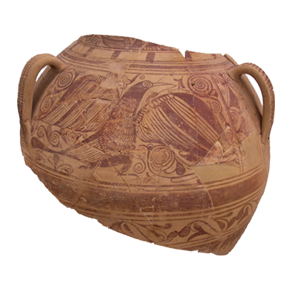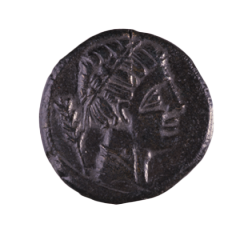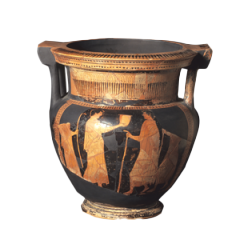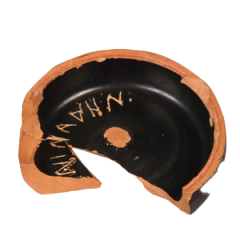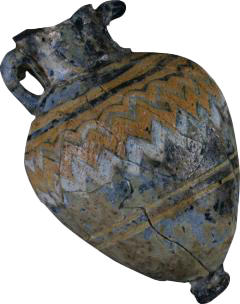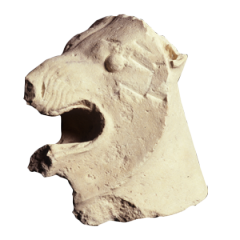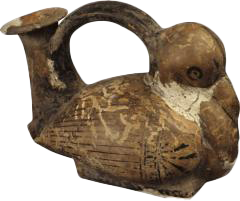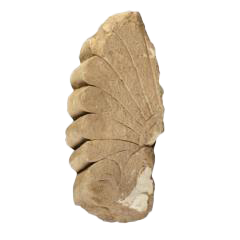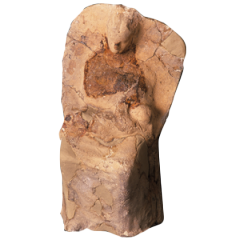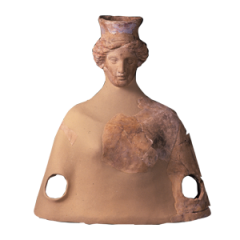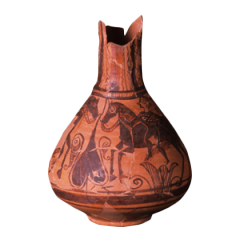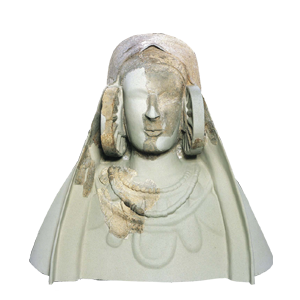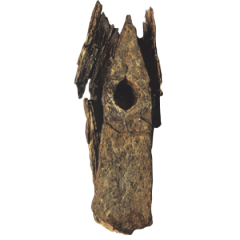
Hoe
La Escuera (San Fulgencio) Iron h: 30 cm; w: 11.4 cm; d: 13.8 cm Iberian 3rd century BC.
Double-sided tool with two opposing edges, one vertical and one horizontal. The central part of the tool has a circular perforation for inserting a wooden handle. It is still very deformed due to exfoliation and separation of the iron sheets that make up the tool.
One of the hallmarks of Iberian culture is its mastery of iron metallurgy. Iron was used to make tools that made it possible to develop new activities and make others more productive, especially in agriculture (hoes, sickles, pruning hooks, etc.). One of the most unusual of these is the large hoe from La Escuera, a unique piece in terms of its dimensions. As its resemblance to the fes, a traditional Valencian agricultural tool, suggests, it was used as an axe on one side and as a hoe on the other. It was especially useful for digging hard ground and uprooting trees, as its heavy weight makes it easier to dig around the trunks; the axe side is used to cut the roots and trunk. Similar, smaller pieces or alcotanas (one example is on display in the Iberos room) were used for stonemasonry, masonry and carpentry work.
C.S.: 2765
NORDSTROM, S., 1967.
- TINAJA CON DECORACIÓN
ESTILO ELCHE-ARCHENA
Tossal de la Cala (Finestrat).
Cerámica
h: 39 cm; a: 46 cm; e: 30 cm
Iberian
Siglos II-I a.C. - ................................................. Bronze ace from the Iberian mint of Saiti (Xàtiva, Valencia). Type Vives 20-2.
- ................................................. Necropolis of El Cabezo Lucero (Guardamar del Segura) Ceramic h: 34'5cm; w: 29'5 cm Iberian 460-450 BC.
- ................................................. Illeta dels Banyets (El Campello) Ceramic h: 11.2 cm; w: 11.2 cm; d: 2.9 cm Iberian. 380-325 BC.
- ................................................. Necropolis of Cabezo Lucero (Guardamar del Segura) Vitreous paste h: 6.5 cm; w: 4.1 cm: 4'1 cm Ancient Iberian Late 5th century BC.
- ................................................. Necropolis of Cabezo Lucero (Guardamar del Segura, Alicante) Limestone h: 27.5 cm; w: 19 cm; d: 23 cm Iberian Second half of the 5th century - beginning of the 4th century BC.
- ................................................. Necropolis of Cabezo Lucero (Guardamar del Segura)
- ................................................. Necropolis of Cabezo Lucero (Guardamar del Segura) Limestone h: 18.5 cm; w: 8.5 cm; d: 5.3 cm Ancient Iberian-Pliocene Second half of the 5th century-early 4th century BC.
- ................................................. DEMETER-LIKE MOTHER-GODDESS Necropolis of La Albufereta (Alicante) Ceramic made with a univalve mould h: 21 cm; w: 11.3 cm; h: 7.5 cm Iberian 4th century BC.
- Terracotta bust ................................................. Necropolis of La Albufereta (Alicante) Terracotta h: 40 cm; w: 37 cm; d: 21.5 cm Iberian 4th-3rd century BC: 37 cm; w: 21'5 cm Iberian 4th-3rd century BC.
- ................................................. Tossal de Manises (Alicante) Ceramic h: 31.5 cm; w: 21.4 cm Iberian Late 3rd century BC.
- ............................................. La Escuera (San Fulgencio) Iron h: 30 cm; w: 11.4 cm; h: 13.8 cm Iberian 3rd century BC.
- ................................................. Necropolis of Cabezo Lucero (Guardamar del Segura, Alicante) Sandstone) Sandstone h: 49 cm; w: 54 cm; d: 33 cm Iberian Late 5th century BC, early 4th century BC.

